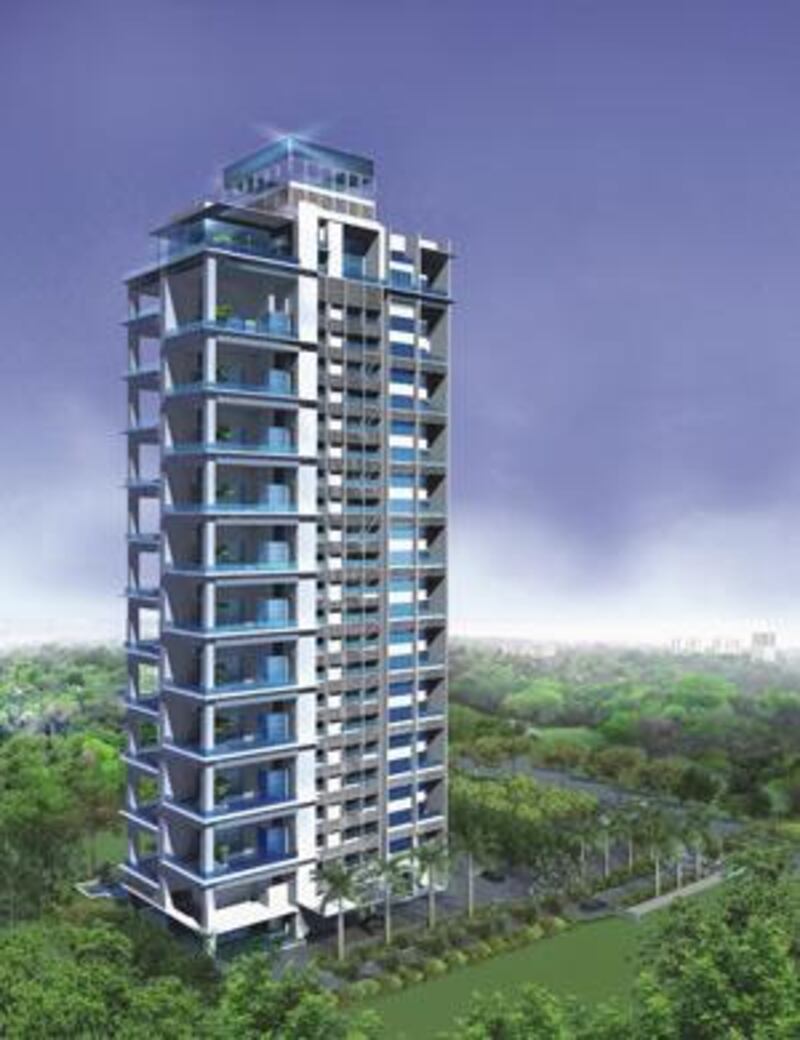God's Blessings will stand out on the low-slung skyline of the Indian city of Pune. The first 100-metre-tall building to be approved there, it offers one premium luxury flat on each of its 25 floors. Priced at between 85 million rupees (Dh6.7m) and 100m rupees, the 7,500-square-foot apartments are six times bigger than normal flats available in the city.
"This is a project the city has never seen before. Living here will offer a unique experience," says Swapnali Bhosale, the director of Avinash Bhosale Group, the developer of God's Blessings. "It will be like owning a bungalow in the air." The project was started in 2007 when the Indian property market was at its peak. It is expected to be ready this autumn. Sales stalled early last year, but picked up towards the end of the year, Ms Bhosale says.
The growing sales of luxury apartments such as those in God's Blessings are indicative of a seismic shift in India's property market, which had been dominated by lower-cost housing for more than a year. In the past decade, India's rapid economic growth gave birth to a housing boom built around the country's emerging middle class and super rich - a 300 million-strong, high-earning, high-spending urban population.
India's construction industry has minted profits by building top-end apartment buildings and shiny high-rises. The Confederation of Real Estate Developers Association of India, a trade group of private developers, reports housing prices have risen along with India's economic fortunes. Prices have been up 16 per cent a year for the past four years. But the global economic downturn knocked the industry back on its heels. Property companies reported a decline in sales with DLF, the country's largest developer, posting a 30 per cent drop in net profits to 4.68 billion rupees for the fourth quarter of last year, compared with 6.71bn rupees for the same period in 2008.
Many companies, eager to raise capital, looked at low-cost housing as a saviour. Several projects promoting tiny, spartan flats with frugal designs, were launched by property firms such as Tata Group. The Indian conglomerate unveiled the Nano Home last year, while the Godrej Group launched low-cost housing projects to tap into a consumer base at the lower end of India's economic pyramid. This economic group, which was bypassed by the previous housing boom, contains 23 million urban families from India's middle and lower-middle classes, whose earnings range between 60,000 rupees and 130,000 rupees. While most do not own their home, they strongly aspire to, reports Monitor India, a research firm based in Mumbai.
Since the economic slowdown, demand for luxury and super-luxury apartments dropped in the first half of last year. Not a single apartment was sold at God's Blessing in that period. Back then, experts predicted that growth in the property industry would hinge on a ravenous demand for affordable housing. But to everyone's surprise, as the economy in the second half of last year improved, the luxury market took off.
A December report by RNCOS, a market research company based in New Delhi, says the luxury sector will grow from US$4.3bn (Dh15.79bn) last year to cross $13bn by 2013. "Presently, the affordable housing, basically targeted at [the] economically weaker class and low-income groups, forms the major portion of the Indian housing Industry in both value and volume terms," RNCOS says. "However, our estimations show that medium and luxury housing segments are expected to witness significant growth in the coming year."
Buoyed by demand, property developers are again focusing on luxury projects. DLF Building sold flats valued at 10bn rupees in the luxury and semi-luxury sector in December alone, the highest monthly sale recorded in the company's history. "There are a host of reasons for improved property sales, besides robust economic recovery," says Rajeev Talwar, an executive director of DLF. "Interest rates are down, property prices have softened by as much as 30 per cent from the peak, and the [stock] markets are now doing well. All these are giving confidence to buyers to buy premium homes."
In the past three months, Indiabulls Real Estate sold 100 flats priced between 70m rupees and 225m rupees in its 65-storey luxury project in Mumbai called Indiabulls Sky. It recently launched Indiabulls Sky Suites, another super-luxury project in Mumbai. Each flat will be more than 10,000 sq ft in area and priced much higher than those in Indiabulls Sky. Kumar Builders, a developer based in Pune, plans to build Sky Villas in the posh Worli suburb of Mumbai. The 8,000 sq ft 'villas will cost upwards of 300m rupees.
Investment in India's residential market will probably top $12.11bn in the next five years, Jones Lang LaSalle, the property agent, says. With that sort of cash floating around, it is not surprising that flats in God's Blessings are popular again. After all, they are spacious and have private plunge pools. Each flat is also fitted with large windows offering a magnificent view of the city of Pune.
"Our project caters to a niche clientele who always had the potential to buy," Ms Bhosale says. "They just wanted to wait till the tight cash-flow situation improved." @Email:business@thenational.ae






